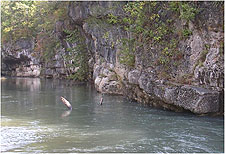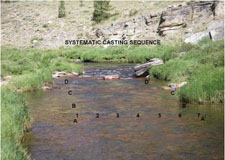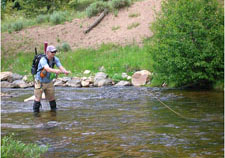Tips for Improving Your Dry Fly Fishing
During almost every fishing trip I learn something new. It may be something that I pick up from a fellow fly fisher, something that I learn from making a mistake or it might be that a light suddenly goes on and I realize that I need to start doing something new or different. Lately I have been keeping a note pad with me and scribbled down things as they happen or as I think of them. Here are a few of them:
 Foam is your friend. In business and in law enforcement the key phrase is “Follow the Money” - in fly fishing the phrase should be “Follow the Foam”. The foam line will tell you two important things: the first thing it tells you is where the main current seams or flow lines are. If the flow of the water is moving the foam along you can be damn sure it is also moving food items along. In fact we have a little ditty about where to fish: “Fish the edges, the ledges and the foam by the rock”.
Foam is your friend. In business and in law enforcement the key phrase is “Follow the Money” - in fly fishing the phrase should be “Follow the Foam”. The foam line will tell you two important things: the first thing it tells you is where the main current seams or flow lines are. If the flow of the water is moving the foam along you can be damn sure it is also moving food items along. In fact we have a little ditty about where to fish: “Fish the edges, the ledges and the foam by the rock”.
Besides telling you how the stream is flowing, the foam line will also tell you how good or bad your drift is. With major drag issues there aren’t any doubts, but detecting minor and less obvious drag can be much harder – “Watch the Foam.” If your fly is moving faster or slower than the foam you have a drag issue. The more the difference in floating speeds, the great the drag issue.
Keep your fly dressed. There are really a couple of different but related issues here. Make sure after each fish you catch or miss that you take a moment to “work on your fly”. Check to see if the wing(s) have rotated out of position or the hackle is damaged. You’ll be surprised how often that happens. Dry off your fly. I’m a bit of a klutz so it doesn’t take me long to lose/dump/you name it, either drying crystals or an Amadou drying pad. If you can keep track of either, use one or the other after each fish, or you can do what I do and simply blow on the fly and blot it on your shirt sleeve.
A little floatant is all you need. In a perfect world a one molecule layer would be just right. An old retired histology professor I knew came close to the perfect world. He dissolved medical grade paraffin in toluene and kept it in a small jar. He would dunk his fly in the jar and then hold it in the air for the toluene to evaporate. His flies would float like corks because of a micro layer of wax. My experience is that most of us put far more floatant on then we need. In fact we may defeat our purpose by adding so much we keep our flies from riding properly on the water. Whether you use one of the gels or a paste, (I’m a Mucilin fan) put just get enough on your index finger and thumb so that they “glisten”.
What part of the fly is in contact with the water? It is the underside – the dubbing and the hackle tips. When you get ready to put floatant on, turn the fly upside down so the bottom is expose. Make sure that is the part that gets a thin coating of floatant. The wings aren’t in contact with the water so they don’t need to be treated.
Drive for show but putt for dough. I’m not a golfer but I understand why this quote is their creed. Work on your short range casts when you practice. Most of the fish we catch are within 20 to 30 feet of us and not 50 plus feet away. When you deduct 8 or 9 feet of rod length, you may only be casting 12 feet of line and leader. Short distance casting is not something that is stressed by most instructors and it is tough. If those are the kind of distance you will be casting you might think about over-weighting your rod by one line weight. It will make those short range casts easier and more accurate.
Many of us have a tendency to make much longer casts than we need. In fact we often end up casting over a good fish or two. Besides lining fish, long casts greatly increase the likelihood of drag problems as your line is going to be crossing more current seams. Far too many people don’t manage their line well enough even on short casts and with long casts they end up with a lot of slack (watch Norm Crisp's video, "Line Management" for more tips on this subject) that has to be moved to set the hook. Or, because of slack, they can’t get enough energy into the line to make another long cast. Rather than make a long cast, keep making shorter casts as you keep moving up the river.
Don’t fall in love with the drift. This tendency goes hand in hand with the long cast tendency and is rather prevalent in those who often fish in crowed locations or have a specific beat to fish. Once you have claimed your territory your casting length and drift defines the boundary. Long drifts almost inevitably start with casting farther than needed and end up in line management problems. Under most dry fly situation keep your drift to about 6 to 8 feet in length. My general rule of thumb is that my drift should only be about as long as I can shoot the line forward on my cast. In some cases I may let my drift so long what I need one false cast to get my fly back where I want it. But, I try to avoid those situations by finding a better casting position. Short drifts are better. After these shorter drifts, take a couple of steps forward and start the process over again. You will cover the same amount of water but your line management should be much less of a problem.

Be systematic in your coverage. My desk and my life are chaotic. But, I’m very systematic in my fly fishing. I’m especially systematic when I’m fishing a section where there are no well defined holding areas and fish could be almost anyplace. This picture is a perfect example. While there are some areas which are a bit more “Primo” than others, for the most part the entire area could likely hold a nice fish. Here is the systematic approach: start by casting to number 1 on line A – A/ and letting your fly drift back about 6 or 7 feet. Make your next cast to number 2 on line A – A/ and again let your fly drift back about 6 or 7 feet. Continue this sequence over to 7. When I finish with line A – A/ I move forward a couple of steps and start the process over at line B – B/, and then move on to lines C – C/ and D – D/ . More often than not, I’ll repeat this sequence of casts one or two more times along each line, often making a few extra cast at a location like the point between C/ and B/.
Let a less than perfect cast lie. I wish I could say that every cast I make is right on the money. More than my share of casts often don’t end up exactly where I want them to go! The natural tendency is to immediately re-cast. Unless the fly lands way off the mark in an area you have already fished or into an area where there is very little likelihood of holding a fish, fish out the drift. Ripping your fly off the water has a better than average chance of spooking any fish nearby. Just relax, fish out the drift and think about what might have caused the problem. Make your next cast the one that counts.
Don’t cast to a rise. I don’t mean just blind cast rather than fish to an actively feeding fish. What I mean is to make a cast that will put your fly in the right position for a take. Typically a trout does not go straight up from its holding position to take a fly. Rather, the trout will drift up and back to take a fly. After taking the fly the trout moves down and forward to its original holding location. That backwards drift will often be one, two or more feet. If you cast into the rise your fly will land a couple feet behind the feeding trout. Cast your fly at least 3 feet above the rise to be sure you fly is upstream in the holding location of the fish.

Pick the best casting position. In some streams, where there are relatively few differences in the current across the stream, you can successfully use an “across and down” drift without having to worry too much about drag. In most streams the flow is turbulent and no where near laminar or is the current the same all the way across the width. In turbulent streams an across the stream drift just won’t work without having to make almost continuous mends. Try and position yourself where you can cast from below and just off to the side of where you expect a rise. As a rule of thumb, a good casting position is about 22 degrees off from the fish. One obvious reason is that since a trout’s field of vision is a little less than 320 degrees, you will be in the “blind” spot. Being slightly off line will also reduce your likelihood of lining the fish. And, you will have the fewest conflicting currents to deal with and should give a better drift.